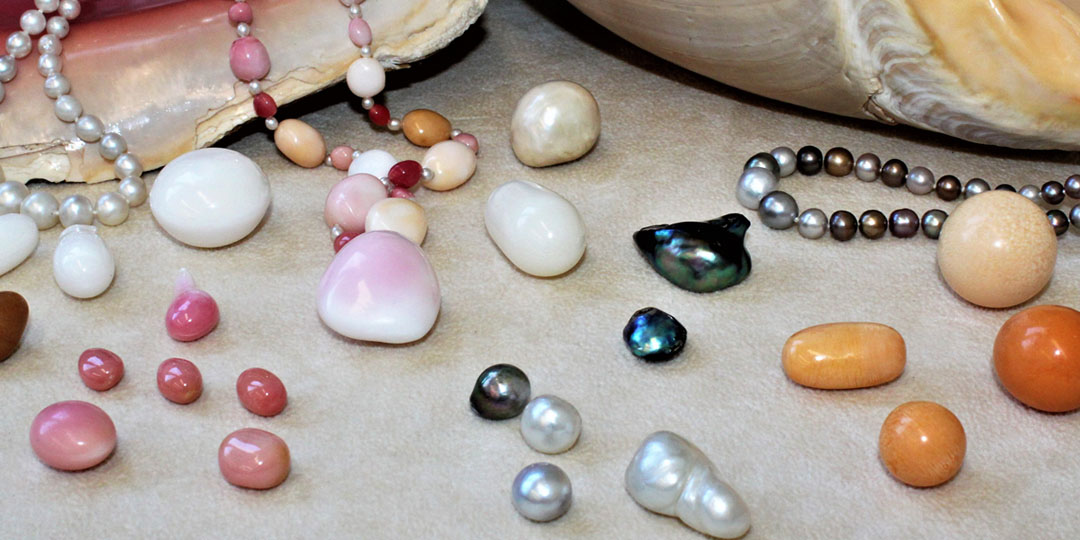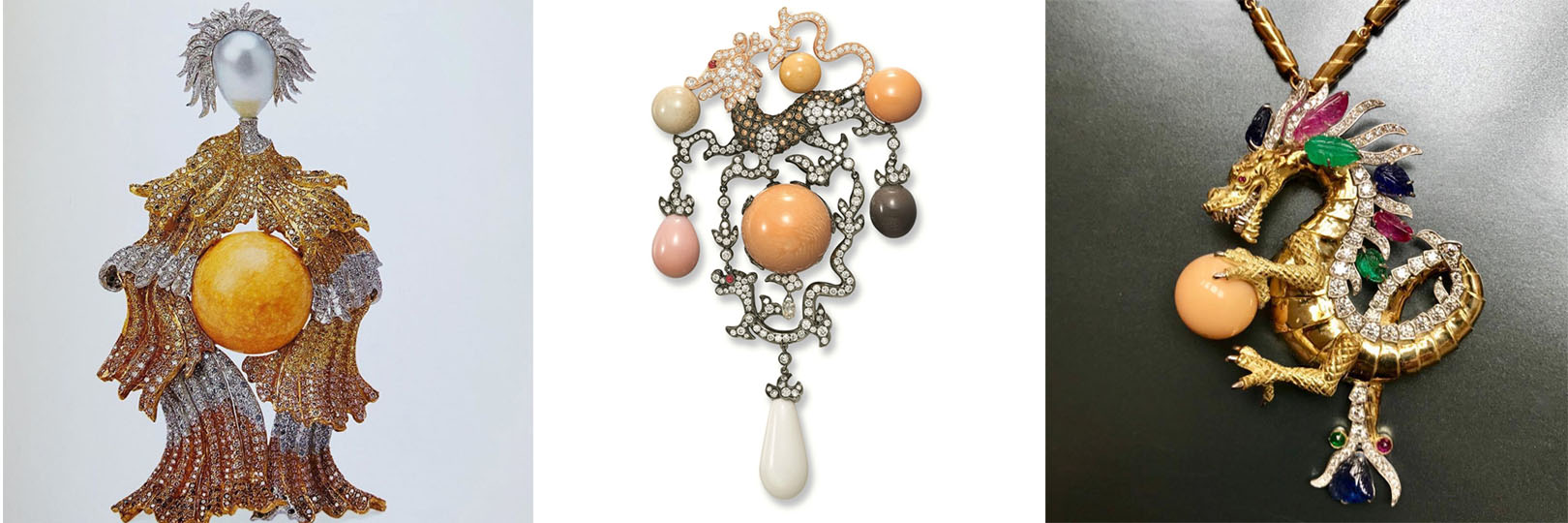PEARLS are one of the most popular and beloved gems in the world. How many of us think that Natural Pearls is synonymous with the colour White, and they are the ones with only milky white spheres?
I would like to bring to your attention the DIFFERENT TYPES AND COLOURS in Natural Pearls that are very rare, highly-priced. After all, it’s always a good idea to add a little splash of colour to enhance your jewel!

Different Types of Natural Pearls featuring: Abalone Pearl, Cassis Pearl, Conch Pearl, MeloMelo Pearl, Clams Pearl, Basra Natural Pearl, Pinctada Radiata Pearl, Pinctada Mazzatlantica Pearl, Pteria Penguin Pearl.
MELO PEARLS:

These pearls are extremely rare, they do not come from an oyster or clam but are formed in the shell of a very large sea snail, known as the Indian Volute or Zebra Snail, found in the waters of Vietnam, Malaysia, Burma, China and the Philippines. Melo pearls do not contain nacre; instead, their composition is calcite and aragonite, giving them a fine glazed surface that sometimes bears flame-like patterns.
Some important facts of Melo pearls are:
All Melo pearls are Natural. There is NO known way to culture these pearls.
– Melo pearls can range from Tan to Dark brown, hitting shades of orange in between.
– Pearls of bright orange colour, round in shape, and showing a flame pattern are the most beautiful and valuable.
– While they are formed in the same way as pearls, with layers of secretions building over foreign intruders, Melo pearls can take decades to grow to significant size and shapes.
These pearls range in sizes from 7mm to up to 40mm, commanding an incredible price.

These pearls were once a sign of royalty in Eastern cultures, even when they were unknown to the rest of the world. They were believed to be droplets that fell from the dragon in the sky. Melo pearls were also worshipped as holy objects, and are never drilled and worn. Emperors would often wear motifs of a dragon chasing a flaming orange pearl.

CONCH PEARLS:
These are the rarest and most Expensive type of Natural pearl in the world. They are formed with no intervention from man. The specific conch (sea snail) that produces the wonderful and rare PINK PEARLS is the Queen or Pink Conch, found in the Caribbean sea.

Some important facts of Conch Pearls are:
-Conch pearls are more scientifically classified as non-nacreous, which means they are not made of nacre, the substance that gives traditional pearls their iridescent lustre.
-These pearls are usually relatively small, averaging around 3mm, and are mainly oval or baroque in shape.
-The value of the Conch Pearl increases drastically depending on the shape, quality, and a property called FLAME, which is an amazing display on the surface of the gem that makes it look like a fire burning on the surface.
-The unique colour of Conch pearls corresponds closely to the colours in conch shells. They vary from cream and light pink through several shades of dark pink, salmon, golden, orange and brown.

Conch Pearls are the rarest and most expensive type of pearls in the world.
It has been estimated that approximately 1 in10,000 Conch, produce a pearl and of these only a few possess the colour, shape, and Flame pattern, necessary to be considered a gem, making them the most expensive and rare Pearls.
Maintenance Tip: Conch pearl colour can fade over time when exposed to sunlight and other factors, so they must be stored and worn carefully.

They were used in the Victorian era, for the carving of cameos and became popular during King Edward’s reign. Conch Pearls are also seen in Art Nouveau jewellery pieces, as seen above.
ABALONE PEARLS:
The most beautiful and the Rarest Pearl varieties in the world. They are Natural Pearls found in the gastropod mollusk Haliotis. The pearls are most often an iridescent blue colour and the most common shape is that of a HORN. Because of their rarity, it’s difficult to find these unique and mesmerising Abalone pearl jewellery.

Some important facts of Abalone Pearls are:
– They are the most colourful of all pearl-producing mollusks.
– Much like traditional pearls, Abalone pearls are formed when an irritant gets into the shell, leading to the layering of colourful nacre, which over time forms into a pearl.
– The value of an abalone pearl is assessed by colour, lustre, shape, heft, and size.
pearls mostly grow in irregular, elongated shapes with most looking like sharks’ teeth or dugout canoes. Perfectly round abalone pearls are almost non-existent. This is why abalone pearls aren’t judged on their shape.
– Due to their irregular shapes, Abalone pearls are difficult to set in jewellery, requiring unique, creative designs that can accentuate the shape of the pearl.
– Abalone pearls are also very fragile and easily damaged making them unsuitable for regular wear and difficult to set in jewellery.
– Unlike most other molluscs, abalone are haemophiliac, meaning that they don’t have a ‘clotting agent’ in their blood. This makes it very difficult to farm the abalone for pearls, as any injury to the animal will likely result in it bleeding to death.

It is estimated that over 100,000 snails need to be harvested, to find just 1 pearl, making them very rare. Abalone pearl cannot be cultured as due to their haemophiliac nature, resulting in the high price with limited supply.
QUAHOG PEARLS:
These are non-nacreous pearls comprised of fibrous aragonite and organic matter. These pearls grow in Mercenaria mercenaria, a hard saltwater clam called the Quahog with a deep purple inner lip. Though these claims are fairly common the pearls they produce are not.

Some important facts of Quahog Pearls are:
– These pearls take about 4-8 years to form, and are most commonly found in white, beige, brown, and sometimes near-black colour.
– The rarest and prized quahogs, however, are purple or lilac, and this variety of clam is the only molluscs capable of producing a truly purple pearl.
– The clams are not used for culturing pearls, because they do not produce nacre, and the clams used in food, and are not used for pearl production, and vice versa, affecting the cost of pearls.

Quahog is one of the only species of mollusc worldwide to produce lavender and purple pearls. This rarity makes them not only beautiful but also very collectable.
The harvesting processing methods destroy almost all pearls that might exist in the shell, 1 in 5,000 shells produces a pearl, most of those that survive are poor quality or damaged. The fact that these pearls take a long time to form naturally and cannot be cultured, explains why they are so valuable. A quahog pearl jewellery is hard to find and they are very brittle and fragile, exceeding the asking price.
With this, I wrap up my article on different types of Naural Pearls, safe to say, the value lies not in the price tag but rather the beauty of this Natural Gemstone.
Mother natures give us such magnificent gems, it’s our duty to take care of our planet and be a good citizen and respect nature!
Content Credit: Gemsociety.org, Lamiacara blog, Pearlsinternational blog.
